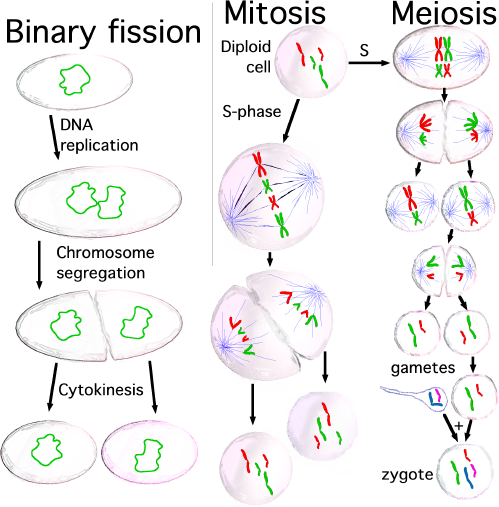Cell division
Cell division is a process by which a cell, called the parent cell, divides into two cells, called daughter cells. Cell division is usually a small segment of a larger cell cycle. In meiosis however, a cell is permanently transformed and cannot divide again.
For simple unicellular organisms such as the Amoeba, one cell division reproduces an entire organism. On a larger scale, cell division can create progeny from multicellular organisms, such as plants that grow from cuttings. Cell division also enables sexually reproducing organisms to develop from the one-celled zygote, which itself was produced by cell division from gametes. And after growth, cell division allows for continual renewal and repair of the organism.
The primary concern of cell division is the maintenance of the original cell's genome. Before division can occur, the genomic information which is stored in chromosomes must be replicated, and the duplicated genome separated cleanly between cells. A great deal of cellular infrastructure is involved in keeping genomic information consistent between "generations".
Variants

Cells are classified into two categories: simple, non-nucleated prokaryotic cells, and complex, nucleated eukaryotic cells. By dint of their structural differences, eukaryotic and prokaryotic cells do not divide in the same way.
Furthermore, the pattern of cell division that transforms eukaryotic stem cells into gametes (sperm in males or ova in females) is different from that of eukaryotic somatic (non-germ) cells.
Prokaryotic cells
Prokaryotic cells are simple in structure when compared to eukaryotic cells. They contain non-membranous organelles, lack a cell nucleus, and have a simplistic genome: only one circular chromosome of limited size. Therefore, prokaryotic cell division, a process known as binary fission, is fast.
The chromosome is duplicated prior to division. The two copies of the chromosome attach to opposing sides of the cellular membrane. Cytokinesis, the physical separation of the cell, occurs immediately.
Eukaryotic cells
- Mitosis: The division of the nucleus, separating the duplicated genome into two sets identical to the parent's.
- Cytokinesis: The division of the cytoplasm, separating the organelles and other cellular components.
- Meiosis: The division of the nucleus in sex cells, making one cell into four sex cells identical to the parent sex cell.
Eukaryotic cells divide by separating the duplicated chromosomes, through movements directed by microtubles. it protect the organ system of our body.
Degradation
Multicellular organisms replace worn-out cells through cell division. In some animals, however, cell division eventually halts. In humans this occurs on average, after 52 divisions, known as the Hayflick limit. The cell is then referred to as senescent. Senescent cells deteriorate and die, causing the body to age. Cells stop dividing because the telomeres, protective bits of DNA on the end of a chromosome, become shorter with each division and eventually can no longer protect the chromosome. Cancer cells, on the other hand, are "immortal." An enzyme called telomerase, present in large quantites in cancerous cells, rebuilds the telomeres, allowing division to continue indefinitely.
Daughter chromosomes
During the metaphase stage of mitosis, chromosomes, which become aligned on the equatorial plane, take on the shape of an "X" as a result of a repelling force between chromosomes. The lobes of the chromosome in this shape are called 'sister chromatids'. The sister chromatids will be attached by a centromere. During metaphase, centromeres of the chromosomes will be aligned in the centre of the nucleus and spindle fibers will be attached to them. In the beginning of anaphase, spindle fibers contract so that the identical chromatids (sister chromatids), which where attached by centromere, will be separated. At this stage, each separated chromatid will act as a chromosome, and the two separated chromatids are called daughter chromosomes.
Phases
See also
References
- Morgan DO. (2007) "The Cell Cycle: Principles of Control" London: New Science Press.
- J.M.Turner Fetus into Man (1978, 1989). Harvard University Press. ISBN 0-674-30692-9
External links
- How Cells Divide: Mitosis vs. Meiosis
- The Mitosis and Cell Cycle Control Section from the Landmark Papers in Cell Biology (Gall JG, McIntosh JR, eds.) contains commentaries on and links to seminal research papers on mitosis and cell division. Published online in the Image & Video Library of The American Society for Cell Biology
- The Image & Video Library of The American Society for Cell Biology contains many videos showing mitosis and cell division.
ar:انقسام خلوي cs:Buněčné dělení da:Celledeling de:Zellteilung ko:세포 분열 it:Divisione cellulare he:רבייה תאית mk:Делба на клетките no:Celledeling simple:Cell division sk:Bunkové delenie sr:Ћелијска деоба fi:Jakautuminen sv:Celldelning th:การแบ่งเซลล์ uk:Поділ клітини